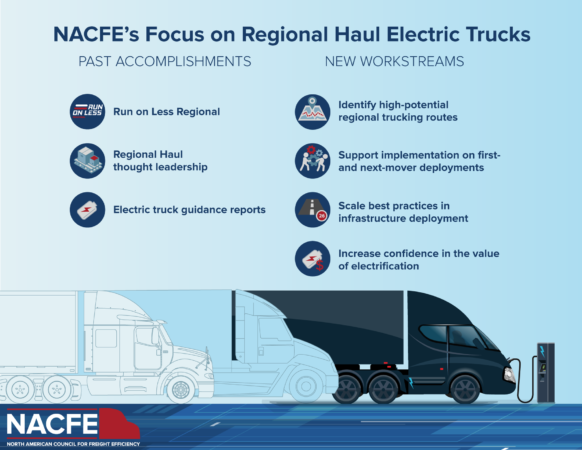Electric vehicle research takes a regional focus

ATLANTA, Ga. – Upcoming North American Council for Freight Efficiency (NACFE) research into electric trucks will focus on regional trucking operations, which are expected to be among the earliest commercial adopters of the equipment.
“Our research has shown us that regional haul is an important segment of the trucking industry and also one that makes sense for electrification — given its shorthaul nature and return-to-base operation,” says executive director Mike Roeth.
Picture trips that can be completed within a day’s drive, and charging that can be completed in a fleet yard.
The three-year research project will also benefit from new funding through the non-profit Hewlett Foundation and the ClimateWorks Foundation.
“This is a big sector, and we’re just starting to understand this regional haul part of trucking,” Roeth explained during a briefing at the annual meeting of the American Trucking Associations’ Technology and Maintenance Council (TMC).
NACFE estimates that the U.S. has about 800,000 regional-haul tractors, which typically run about 65,000 miles a year. That accounts for 52 billion miles annually – about 10 times more than the annual miles traveled by transit buses or school buses.
Answering questions
Even one of North America’s largest fleets will benefit from the help.
“It’s really helpful for me to be able to rely on someone else in addition to my own team,” said Schneider executive vice-president and CAO Rob Reich, who also serves as chairman of NACFE’s board. “What are all those questions that historically we’ve never had to think of?”
Some of the first research will involve identifying regional trucking routes with a high potential for electrification, supporting deployments outside of California, scaling best practices in infrastructure development for fleets and communities alike, and increasing confidence in the value of electrification.
The routes with the highest potential are not expected to be limited to travel distances alone. Many could leverage financial support from states or communities that are interested in zero emissions, or utilities that are looking to maximize economic development opportunities, Roeth said.
“There’s so many benefits to these trucks that people are going to want to help to spur them along,” he said, referring to funding from California-based utilities as an example.
A growing segment
The regional hauls represent a growing share of North America’s trucking industry. Trends such as e-commerce, for example, have seen an increase in the number of warehouses and distribution centers located closer to end users. That leaves shorter trips between warehouses, distribution centers, and fulfillment centers to be completed.
This is not the council’s first look at battery-electric vehicles, of course. It all builds on related work such as the Run on Less Regional fuel-efficiency challenge, and Guidance Reports on electric trucks. The publications have explored arguments for and against electric vehicles, applications for medium-duty trucks, charging needs, the opportunities for heavy-duty tractors, and a payback calculator already being used by fleets such as UPS and London-based Arrival.
The coming year alone will see workshops hosted during the Green Truck Summit, the annual meeting of the National Private Truck Council, and ACT Expo.
Electric vehicles are coming
Manufacturers are not yet taking orders and building electric vehicles in large volumes. But established OEMs are placing test vehicles into customer hands throughout 2020.
“The future,” says Roeth, “is coming fast.”
Plenty can be accomplished without establishing a national fast charging network at truck stops across the country, he added. “We’ve got a lot of opportunities to crawl and walk here before we think about running.”
Granted, there are plenty of questions to be answered. Challenges range from dealing with brownouts to sourcing technicians. Charging still takes more time than filling a tank with diesel.
“We’re starting with an industry that actually has no footprint,” said Rick Mihelic, director – future technology studies. There are no electric vehicle technicians, or even established technical centers to train them. “All of that needs to have some seed money to get that started.”
But there also opportunities to apply the lessons learned by those who were early adopters of compressed natural gas (CNG) vehicles.
The CNG fleets didn’t benefit from the critical mass that is being realized with electric vehicles of other sizes, Mihelic said, using Tesla’s charging network as an example. “Now you’re looking at electrifying airplanes. You’re looking at electrifying ships.”
Changes can even happen quicker than some people expect. Diesel-powered electric trains were a new idea in the 1940s, he observed. In just 20 years they replaced all coal-fired trains.
“We’re right there at the start of that S curve [with electric vehicles].”
Have your say
This is a moderated forum. Comments will no longer be published unless they are accompanied by a first and last name and a verifiable email address. (Today's Trucking will not publish or share the email address.) Profane language and content deemed to be libelous, racist, or threatening in nature will not be published under any circumstances.